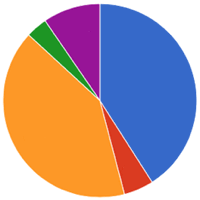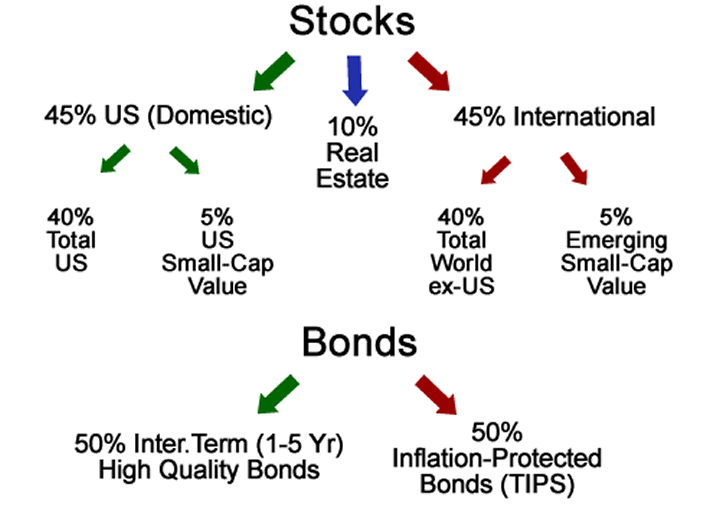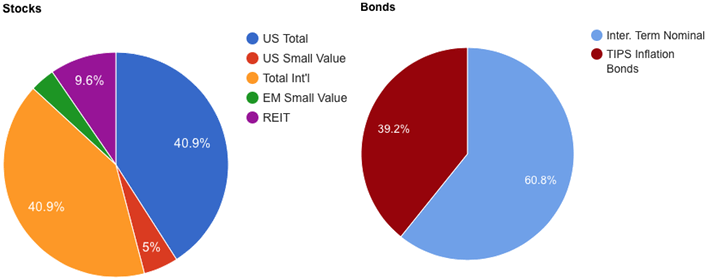 Here is a roughly mid-year 2016 update on my investment portfolio holdings. This includes tax-deferred accounts like 401ks, IRAs, and taxable brokerage holdings, but excludes things like our primary home and cash reserves (emergency fund). The purpose of this portfolio is to create enough income to cover household expenses.
Here is a roughly mid-year 2016 update on my investment portfolio holdings. This includes tax-deferred accounts like 401ks, IRAs, and taxable brokerage holdings, but excludes things like our primary home and cash reserves (emergency fund). The purpose of this portfolio is to create enough income to cover household expenses.
Target Asset Allocation

I try to pick asset classes that will provide long-term returns above inflation, distribute income via dividends and interest, and finally offer some historical tendencies to balance each other out. I don’t hold commodities futures or gold as they don’t provide any income and I don’t believe they’ll outpace inflation significantly. In addition, I don’t have enough “faith” in their fundamentals to hold them through an extended period of underperformance (i.e. don’t buy what you don’t can’t stick with).
Our current target ratio is 70% stocks and 30% bonds within our investment strategy of buy, hold, and rebalance. With a self-managed, simple portfolio of low-cost funds, we minimize management fees, commissions, and income taxes.
Actual Asset Allocation and Holdings

Stock Holdings
Vanguard Total Stock Market Fund (VTI, VTSMX, VTSAX)
Vanguard Total International Stock Market Fund (VXUS, VGTSX, VTIAX)
WisdomTree SmallCap Dividend ETF (DES)
WisdomTree Emerging Markets SmallCap Dividend ETF (DGS)
Vanguard REIT Index Fund (VNQ, VGSIX, VGSLX)
Bond Holdings
Vanguard Limited-Term Tax-Exempt Fund (VMLTX, VMLUX)
Vanguard Intermediate-Term Tax-Exempt Fund (VWITX, VWIUX)
Vanguard High-Yield Tax-Exempt Fund (VWAHX, VWALX)
Vanguard Inflation-Protected Securities Fund (VIPSX, VAIPX)
iShares Barclays TIPS Bond ETF (TIP)
Individual TIPS securities
U.S. Savings Bonds (Series I)
Commentary
Since my last quarterly update, I’ve done the “just keep swimming, just keep swimming” thing and continued dollar-cost-averaging into the same investment mix. Nothing seems like a great deal, but I remain optimistic. I have not made any sell transactions. I still hold WisdomTree SmallCap Dividend ETF (DES) and WisdomTree Emerging Markets SmallCap Dividend ETF (DGS), as I still like the idea of holding a bit extra of those asset classes even though the ETFs available are not all that great.
I’m still somewhat underweight in TIPS mostly due to limited tax-deferred space as I really don’t want to hold them in a taxable account. (I should note that shares of TIP and VIPSX are up roughly 7% YTD, but the forward real yield is now negative). My taxable bonds are split roughly evenly between the three Vanguard muni funds. The average duration across all of them is roughly 4.5 years.
A simple benchmark for my portfolio is 50% Vanguard LifeStrategy Growth Fund (VASGX) and 50% Vanguard LifeStrategy Moderate Growth Fund (VSMGX), one is 60/40 and one is 80/20 so it also works out to 70% stocks and 30% bonds. That benchmark would have a total return of -0.87% for 2015 and +6.61% YTD (as of 7/31/16).
I like tracking my dividend and interest income more than overall market movements. In a separate post, I will update the amount of income that I am deriving from this portfolio along with how that compares to my expenses.
 The Best Credit Card Bonus Offers – 2025
The Best Credit Card Bonus Offers – 2025 Big List of Free Stocks from Brokerage Apps
Big List of Free Stocks from Brokerage Apps Best Interest Rates on Cash - 2025
Best Interest Rates on Cash - 2025 Free Credit Scores x 3 + Free Credit Monitoring
Free Credit Scores x 3 + Free Credit Monitoring Best No Fee 0% APR Balance Transfer Offers
Best No Fee 0% APR Balance Transfer Offers Little-Known Cellular Data Plans That Can Save Big Money
Little-Known Cellular Data Plans That Can Save Big Money How To Haggle Your Cable or Direct TV Bill
How To Haggle Your Cable or Direct TV Bill Big List of Free Consumer Data Reports (Credit, Rent, Work)
Big List of Free Consumer Data Reports (Credit, Rent, Work)
It would be interesting to see what the breakouts are by income.
For example, real estate is 20% of my portfolio but makes up 75% of my retirement income.
And yes, I’m working to lower that percentage. 🙂
Jonathan – Great blog. I’m a regular reader,
I was doing my mid-year rebalance and noticed that international equity funds did terrible over the past 10 years, I have a fair amount of money in international equities, as do you. I’m considering lowering the % because they generally under perform US funds. Would love your thoughts.
@Paul – Good question, I will try to put together a post on that. I’ve been buying a lot of international equity recently as well.
Sounds like a “buy low” opportunity.
Jonathan,
I’m a long time reader of your blog and happen to be in the same target asset class allocation mix – 70% stock and 30% bonds. I agree that you can blend two Vanguard Index funds to get a desired allocation for your BM. Alternatively, you can use FASGX – Fidelity Asset Manager® 70% Fund.
I assume that each month you, a person who stays on top of his finances, take a closing price for a given fund and calculate its return. I’ve tried to calculate returns for one of the index funds going back 3 years using historical prices from Yahoo finance. I used adjusted close price to account for dividends, etc. One month later, I found out that adjusted price changes over time as funds pay dividends, etc. and returns change slightly.
Any ideas how I can correctly calculate historical returns and continue return calculations without looking back for adjustment of historical prices? Should I just use unadjusted closing price and treat dividend payments (I believe they are paid annually) like cash flow? I know how to do geometrically linked calculations, etc., but am not sure if I’m using correct data points from index funds as my BM.
Am I missing something? Your thoughts are greatly appreciated.
I usually use Morningstar total return data for mutual funds and ETFs, which includes the effects of dividends. I don’t use Yahoo Finance data.
I started reading your blog almost 10 years ago when online banks offered great interest rates.
Do you still hold cash and if so what % and kind of accounts do you use to get maximal yield
I notice you have most of your money in stocks and corporate bonds; little slivers in real estate and TIPS.
I wonder if you implement stop-outs in case of significant trend reversals.
Your portfolio appears highly leveraged to bull market environments. I wonder how you protect your assets when the bull market ends and a bear market persists for months or years. TIPS looks to be the only thing in your portfolio that can perform well in this scenario.
I wonder if you’d consider allocating to a Managed Futures strategy and / or overlaying Trend Following rules on your portfolio to protect yourself.
i am happy to c u got Vanguard as they are the best fee of 0.05%
Hi just curiuos why you own VTI, VTSMX, VTSAX, shouldn’t owning 1 of these do the job?
I just list all the flavors so that folks know that they are the same thing.
Hi Johnathan, Hope all is well on your end. I am a long time follower of your blog. Just wondering if you plan to post any recent update on your portfolio given that markets have changed so much in the past 1 yr. Thanks.
Sorry forgot to check the notify button.